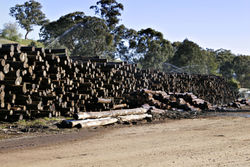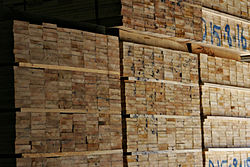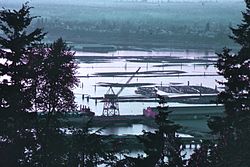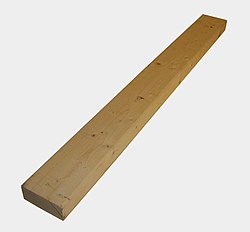Lumber
Lumber (or timber) is wood that has been cut for use in building.
Dimensional lumber
Dimensional lumber is a term used in North America for lumber that is finished/planed and cut to standardized width and depth specified in inches.
Softwoods
| Softwood Dimensional Lumber Sizes | |||
|---|---|---|---|
| Nominal | Actual | Nominal | Actual |
| 1 × 2 | ¾″ × 1½″ (19×38 mm) | 2 × 2 | 1½″ × 1½″ (38×38 mm) |
| 1 × 3 | ¾″ × 2½″ (19×64 mm) | 2 × 3 | 1½″ × 2½″ (38×64 mm) |
| 1 × 4 | ¾″ × 3½″ (19×89 mm) | 2 × 4 | 1½″ × 3½″ (38×89 mm) |
| 1 × 6 | ¾″ × 5½″ (19×140 mm) | 2 × 6 | 1½″ × 5½″ (38×140 mm) |
| 1 × 8 | ¾″ × 7¼″ (19×184 mm) | 2 × 8 | 1½″ × 7¼″ (38×184 mm) |
| 1 × 10 | ¾″ × 9¼″ (19×235 Mm) | 2 × 10 | 1½″ × 9¼″ (38×235 mm) |
| 1 × 12 | ¾″ × 11¼″ (19×286 mm) | 2 × 12 | 1½″ × 11¼″ (38×286 mm) |
| 3 × 4 | 2½″ × 3½″ (64×89 mm) | 2 × 14 | 1½″ × 13¼″ (38×337 mm) |
| 4 × 4 | 3½″ × 3½″ (89×89 mm) | 6 × 6 | 5½″ × 5½″ (140×140 mm) |
| 4 × 6 | 3½″ × 5½″ (89×140 mm) | 8 × 8 | 7¼″ × 7¼″ (184×184 mm) |
Examples of common sizes are 2×4 (also two-by-four and other variants), 2×6, and 4×4. The length of a board is usually specified separately from the width and depth. It is thus possible to find 2×4s that are four, eight, or twelve feet in length. In the United States the standard lengths of lumber are 6, 8, 10, 12, 14, 16, 18, 20, 22, and 24 feet.
Non-North American sizes
| Examples of Dimensional Lumber Sizes (Softwood and Hardwood) | |||
|---|---|---|---|
| Inch name | Sawed | Swedish | Australian |
| 2 × 4 | 50 x 100 mm | 45 × 95 mm | 45 x 90 mm |
| 1 × 3 | 25 × 75 mm | 22 × 70 mm | 19 x 70 mm |
| 3 × 3 | 75 × 75 mm | 70 × 70 mm | 70 x 70 mm |
| 2 × 7 | 50 × 175 mm | 45 × 170 mm | Not used |
| 2 × 3 | 50 × 75 mm | 45 × 70 mm | 45 x 70 mm |
| 1 × 4 | 25 × 100 mm | 22 × 95 mm | 19 x 90 mm |
| 1 × 5 | 25 × 125 mm | 22 × 120 mm | 19 x 120 mm |
| 2 × 5 | 50 × 125 mm | 45 × 120 mm | 45 x 120 mm |
Outside North America sizes of timber vary slightly. Sizes are, in some cases, based on the imperial measurement and referred to as such; in other cases the sizes are too far removed from the imperial size to be referred to by imperial measurement. Lengths can be sold at every 300 mm (a metric approximation of 1'). Common sizes are similar to the North American equivalent; 2.4, 2.7, 3.0, 3.6, 4.2, 4.8, 5.4, 6.0. But also in running lengths, where each plank in a given packet is different, from 2500mm to 5500mm, though shorter and longer may be present.
Hardwoods
| Hardwood Dimensional Lumber Sizes | |||||||
|---|---|---|---|---|---|---|---|
| Nominal | Surfaced 1 Side (S1S) | Surfaced 2 sides (S2S) | |||||
| ⅜″ | ¼″ | 3/16″ | |||||
| ½″ | ⅜″ | 5/16″ | |||||
| ⅝″ | ½″ | 7/16″ | |||||
| ¾″ | ⅝″ | 9/16″ | |||||
| 1″ or 4/4 | ⅞″ | 13/16″ | |||||
| 1¼″ or 5/4 | 1⅛″ | 1-1/16″ | |||||
| 1½″ or 6/4 | 1⅜″ | 1-5/16″ | |||||
| 2″ or 8/4 | 1-13/16″ | 1¾″ | |||||
| 3″ or 12/4 | 2-13/16″ | 2¾″ | |||||
| 4″ or 16/4 | 3-13/16″ | 3¾″ | |||||
In North America sizes for dimensional lumber made from hardwoods varies from the sizes for softwoods. Boards are usually supplied in random widths and lengths of a specified thickness, and sold by the board-foot (144 cubic inches).
Engineered Lumber
Engineered lumber is lumber created by a manufacturer and designed for a certain structural purpose.
Lumber Media
Wood cut from Victorian Eucalyptus regnans
A sawmill with the floating logs in Kotka, Finland
The longest plank in the world (2002) is in Poland (near Szymbark) and measures 36.83 metres (about 120 ft 10 in) long.
Related pages
Other websites
- Timber Development Association of NSW - Australia
- CPSC Test coatings to reduce arsenic emissions from pressure treated wood[dead link]
- TRADA: Timber Research And Development Association Archived 2010-03-06 at the Wayback Machine
- The Forest Products Laboratory. US main wood products research lab. Madison, WI (E) Archived 2010-01-06 at the Wayback Machine
- International Wood Collectors Society
- Xiloteca Manuel Soler (One of the largest private collection of wood samples)






